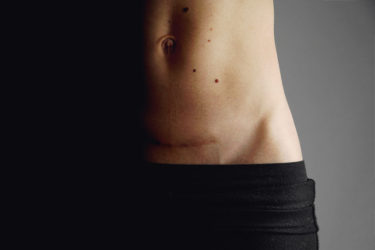
“What?” The client looks at me, incredulous. “How can my frozen shoulder possibly have anything to do with the fact that I had two C-sections over thirty years ago?” Well, that is going to take some ‘splainin’.
If you have had a C-section (or two as in many cases), you likely went on your merry way afterwards thinking you were just fine. You stopped having pain and got back to doing all the things busy moms do, so you must be fine right? The truth is, you may be functioning normally but things are still stuck down there where your scar is. You have merely found a very clever way to work around it. The problem is, you will eventually pay for those compensatory movement patterns you’ve developed. It just may be so far down the road that you don’t link the two together.
What’s really going on in there?
When you are at the end of your pregnancy, you feel like your belly enters the room a few seconds before the rest of you. With a uterus that big, you probably assumed that when a C-section is performed the first thing they see once they cut you open surely must be your uterus. In fact, it is not. The first thing in the way is loops of your small intestine. These loops are sandwiched between two thin layers of tissue (think of this like a dry cleaning bag) that keep the intestines from getting tangled.
This dry cleaning bag containing intestines hangs down like a skirt in front of the uterus. The bottom edge of the skirt is not tethered to anything, so the surgeon is able to lift the whole thing and move it out of the way to get to the uterus. After baby is birthed, the uterus and then the layers of the abdominal wall are sutured back together.
A sticky situation
The problem is that as these layers heal, the bottom of the dry cleaning bag gets stuck down with scar tissue. How does this effect movement? It does in a few different ways.
First of all, when things get tethered down in the front this fixes the pelvis in a forward tilt with the pubic bone pointing more downward rather than forward. This alignment puts lots of pressure on the lower back as it gets pulled into a very arched position. Over time this can lead to degeneration of the joints and discs in the lower back, so one day you bend over to pick up a sock off the floor and searing pain stops you from getting back up.
Being tethered down in the front can also affect things like your neck and shoulders. A good way to picture this is to raise one arm in the air and see how the bottom of your shirt moves up as you do this. Now firmly hold down the bottom of your shirt and try to raise your arm the whole way up. You have to work much harder to do it, don’t you? The bag of intestines is like the bottom of your shirt. When you raise your arms or extend your neck to tilt your head back, it should lift up to allow the movement. When it is tethered it makes it much more difficult.
Mystery visitor from the past?
The result is a lot of stress on your neck and shoulders, which will take a toll over the years following your C-section. Eventually (as in decades later in a lot of cases) some problem such as a frozen shoulder or osteoarthritis in your neck will appear, and most people have no idea that is in fact caused by the tethering around your C-section scar.
The take home lesson here is get your C-section scar area treated once everything is healed. Through gentle hands-on treatment techniques, we can free the dry-cleaning bag of intestines so that it floats freely again. This will get your pelvis back in alignment, relieve the stress on your lower back, and prevent future issues in your neck and shoulders. If you have had a C-section at any time in your past, no matter how long, come in and see us. We want to help you prevent problems in the future.